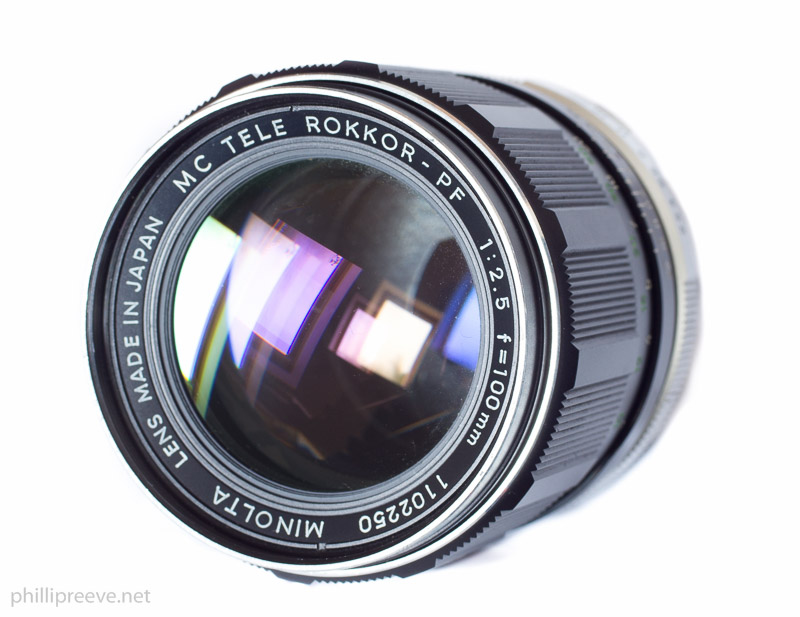
Despite it’s age of more than 45 years the Minolta MC 2.5/100 is a very good lens with great built quality and bokeh for a very affordable price.
Sample Images

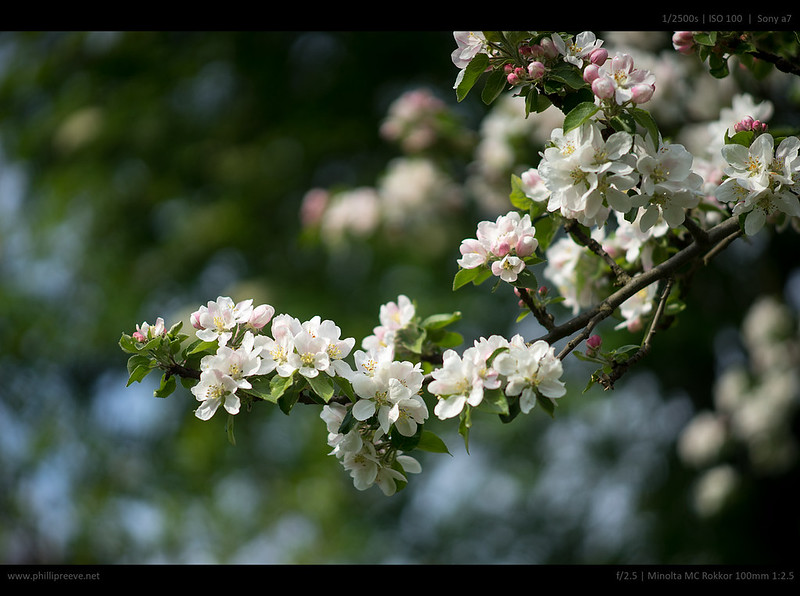
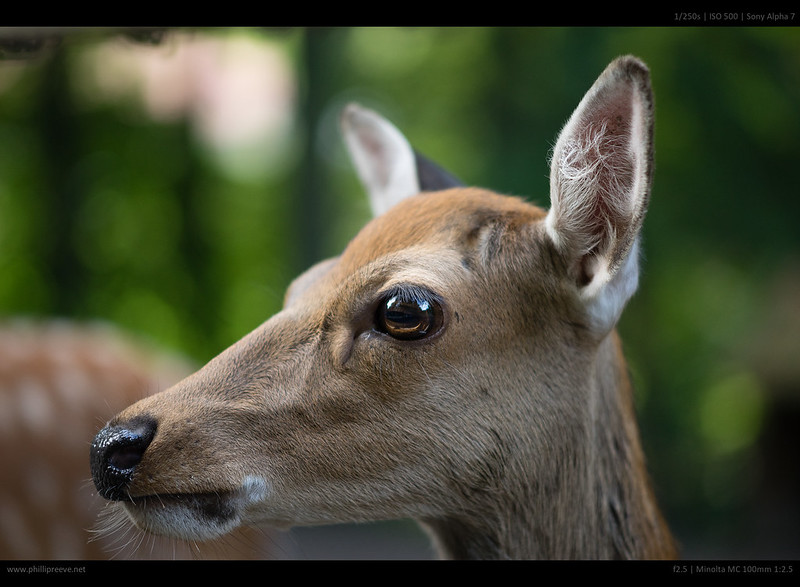
Specifications
| Diameter | 68mm |
| Length | 65mm |
| Filter Diameter | 55 mm |
| Weight | 410g |
| Max. Magnification | ~0.2 |
| Close Focusing Distance from the sensor | 120cm |
| Number of aperture blades | 6 |
| Elements/ Groups | 6/5 |
The Minolta MC 2.5/100 at ebay.de | ebay.com (affiliate links)
Versions
Minolta made quite a few MC 2.5/100 lenses.
-
-
- The first version was introduced in 1968 and it has a flat all metal focusing ring. It is the version I own and all the pictures in this review show it.
- The second version was introduced in 1970, it has a focusing ring of the hill/valley type but otherwise it is very similar to the first version.
- The third version was introduced in 1973 and it has a rubberized focusing ring and weigths 20g more than it’s two precedessors. The optical design and short focusing distance of 1.2m are the same. Minolta also dropped the “-PF” from the name during the production run for this version.
- The fourth version introduced in 1976 has a different (but similar) optical design (5 lenses in 5 groups). It is also a bit shorter, thinner and lighter than it’s precedessor. The easiest way to tell it apart from the others is the short focusing distance of just 1m.
-
Data according to the Minolta manual lenses list.
There are also two version called Minolta MD Rokkor 100mm 1:2.5 which are the same optically as the fourth MC version. For a short time I owned one, the performance was very similar to my first MC version but I preferred the focusing ring of the MC so I sold it.
Then there is the Minolta MD 100mm 1:2.5 which has a 49mm filter diameter and a little modified optical design. At 310g it is significantly lighter than all the other versions. Built quality will be similar to that of my MD 2/50.
Compatibility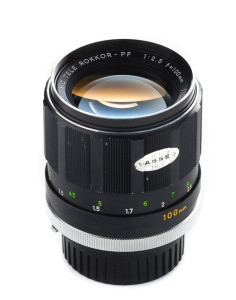
You can use the lens on a wide range of old Minolta SR film-cameras like the Minolta XD-7 or X-700.
Because of the flange-focal-distance of Minolta SR lenses all adapters for DSLR cameras either contain an optical element which will reduce image quality a lot or you lose infinity focus. I wouldn’t bother to use one of those adapters.
Mirrorless cameras have a much shorter flange focal distance and you can buy adapters for Fuji-X, Sony-E, Micro Fourthirds and Samsung NX which work very well.
I usually recommend Sony Alpha 7 cameras for the use with older manual lenses because they are the only ones with a fullframe sensor and in my experience most lenses work best on the larger sensor. But I got nice results with this lens on the Nex-5n as well.
Here are links to adapters for Minolta SR to Sony E mount cameras: Amazon.com | Amazon.de (affiliate links).0
Also check out my Minolta SR-mount adapter guide.
Built Quality
This lens is one of the most beautifully made lenses I have ever owned. Everything is made from metal and even though my lens is more than 45 years old and I use it regularly it shows less signs of wear than my Sony FE 2/28 which I bought 6 months ago.
The focusing ring is super smooth with just the right amount of resistance.
Size, Weight and Handling
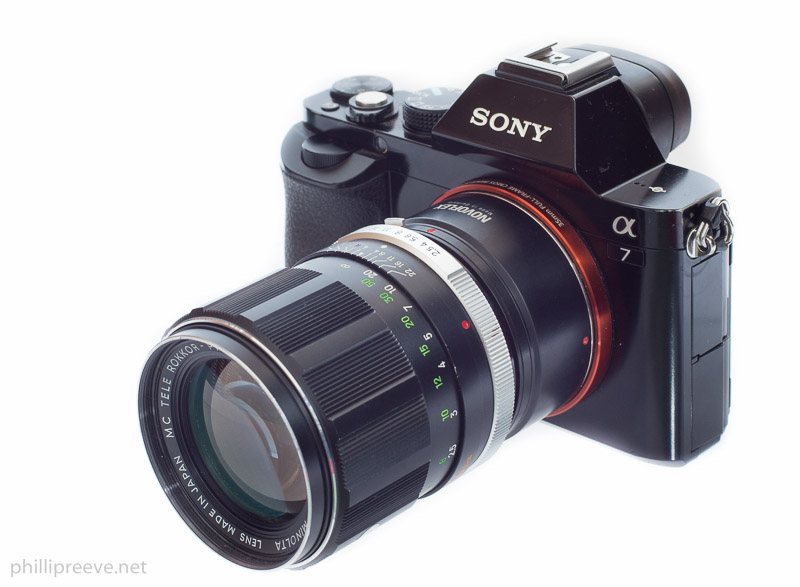
The lens feels well balanced on my rather light Alpha 7, on my small Nex-5n it is a bit front heavy.
The focusing ring travels about 90° from 1.2m to 2m and a further 110° to infinty. This focus throw is just right for porttraits and also landscape images. This is one reason why I prefer it for portraits over my Tokina 2.5/90 Macro.
The short focusing distance of 1.2m is a bit high in my opinion.
The Minolta Closeup Lens No. 0 works well with the MC 2.5/100 and reduces the short focusing distance to 67cm but you can’t focus past 1.2m when it is attached. I would recommend to stop down to at least f/4 when using the closeup lens.
Sample Image normal short focusing distance | short focusing distance with Minolta Closeup Lens No 0 f/2.5(soft) | f/5.6 (quite sharp)
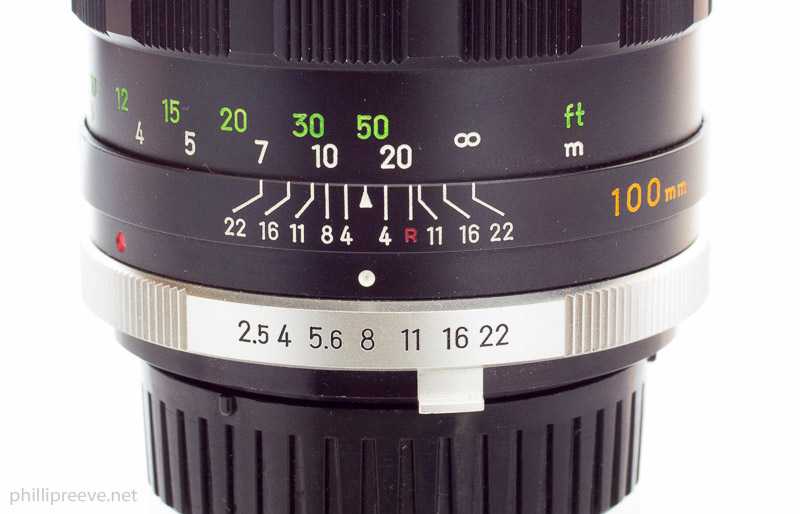
The metal made aperture ring of the has a perfect resistance and distinctive stops. There is no stop between f/2.5 and f/4, then it stops down half steps to f/22.
The filter thread does not rotate when the lens is focused which makes the usage of polarizers easier. The lens extends by about 10mm when focused to 1.2 meters.
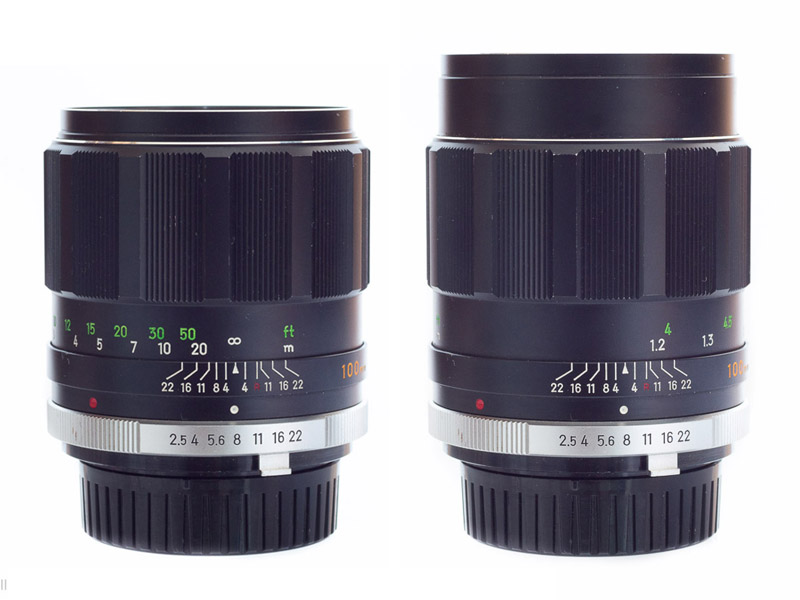
Lens Hood
I don’t own the original lens hood. It is quite long and made from metal. I use one for the MD 4.5/75-200 instead which is a bit smaller and works well enough.
Optical Performance
Flare Resistance
Not a strength of the MC 2.5/100. It easily loses contrast when a bright light shines on the front of the lens.
Distortion
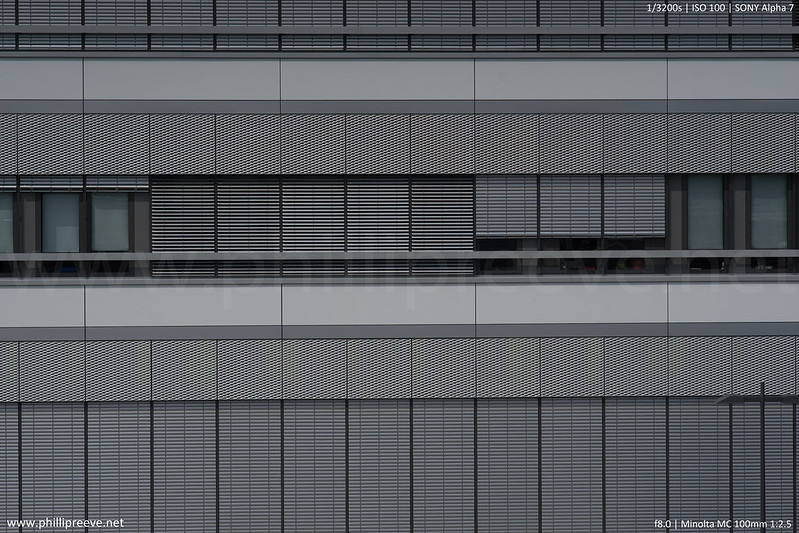
A very small amount of pincushion distortion, only relevant for the most critical applications.
Vignetting
There is minor vignetting at f/2.5 which is gone by f/4.
Chromatic Aberations
LoCA and LaCA are both visible in critical situation but not too obtrusive.
Bokeh
The lens has beautifully smooth bokeh. I would go as far as to say that it has the most beautiful bokeh of any Minolta lens I have ever used. But that is quite subjective, here are a few pictures to judge for yourself:
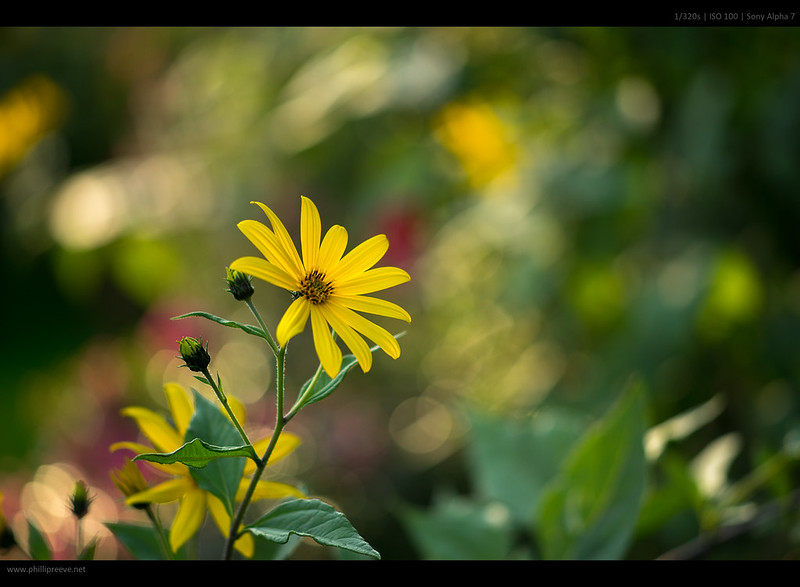
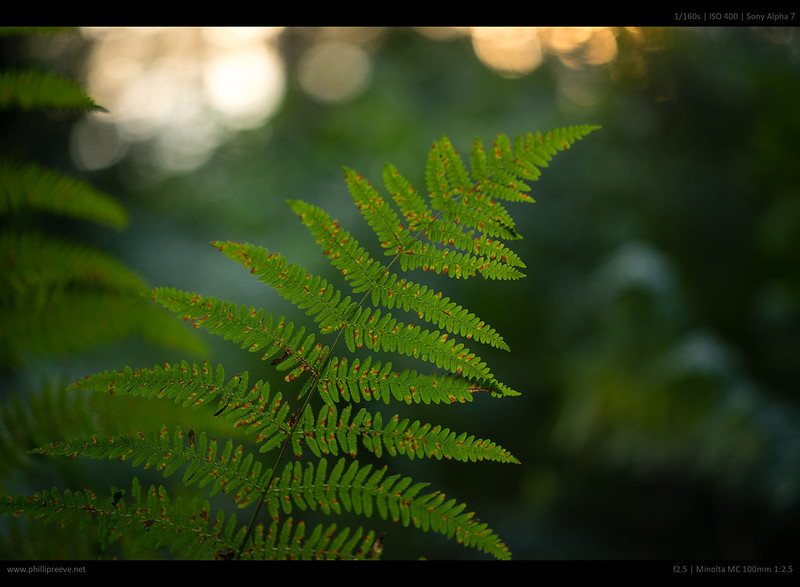
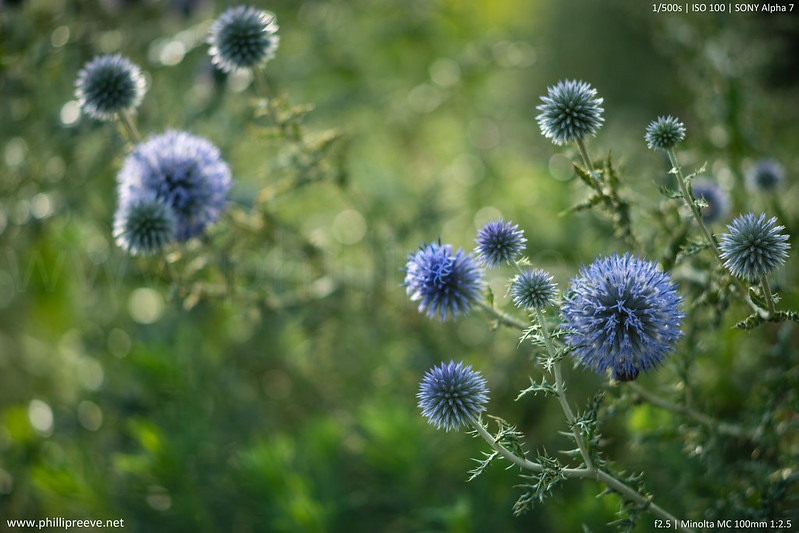
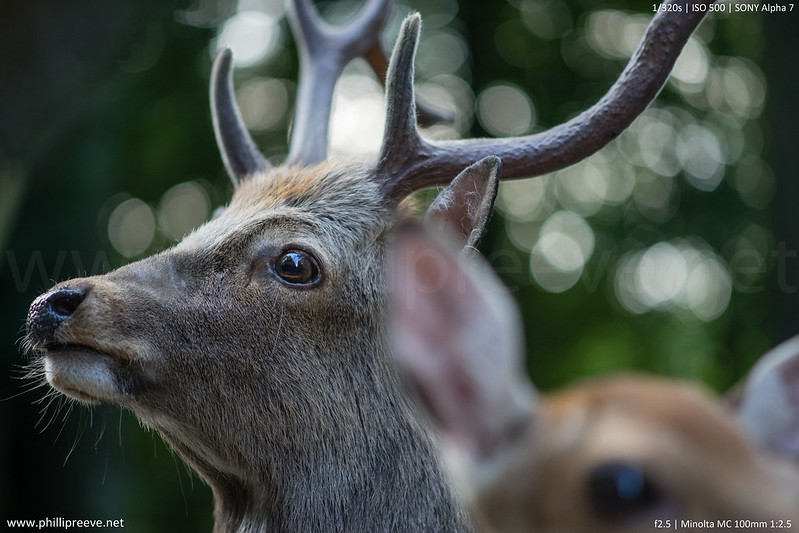
Sharpness
- f/2.5: I see a lot of resolution but reduced contrast. Good to very good in the center, the corners are good. I think the lens performs a bit better at medium distances of 3-4m.
- f/4: The center improves noticeably to very good levels, the midframe area is good to very good and the corners improve only a little.
- f/5.6, f/8: Very sharp across the frame.
- f/11: A little softer due to diffraction.
The Minolta MC Tele-Rokkor PF 100mm 1:2.5 does not set any resolution record but it is sharp enough at f/2.5 with very good resolution and some spherical aberration.
By f/5.6 it leaves little to be desired.
Compared to other lenses
- Tokina 2.5/90 Macro: It is a sharper at f/2.5 and it is more flexible because of the much shorter minimal focusing distance. So usually it make sense for me to carry the additional 100g. But the Tokina has a rather short focusing throw at portrait distances, inferior bokeh and it is much more expensive nowadays. So I prefer the Minolta for portraits.
review | 530g | about $350 used | at ebay.com (affiliate link) - Minolta MC 2/100: This lens was the predecessor of the 2.5/100, despite being faster it only weighs 15g more. Because this lens is quite rare, said to be not very robust and expensive very little is known about it’s actual performance.
short review | 425g | about $500 used | at ebay.com (affiliate link) - Minolta MC 1.7/85: This lens is much more expensive and a bit heavier. It is also softer and the bokeh isn’t as nice at f/1.7 (compared to f/2.5 on the 100). By f/2.8 it performs quite well.
sample images | 460g | about $500 used | at ebay.com (affiliate link) - Nikon AI-S 2.5/100: This is a legendary lens and I think it has more contrast at f/2.5 but I like the bokeh of the Minolta better. Stopped down it will be hard to tell both lenses apart.
mtf chart | FM-forums | 435g | about $250 used | at ebay.com (affiliate link) - Zeiss Macro Planar 2/100: This is the benchmark of 100mm lenses. It shows an excellent performance from f/2 and the bokeh is superb as well. LoCA seems to be the only issue of this lens. Oh and the price and size are noteworthy as well.
MTF-data | review | 660g | about $1100 used | at ebay.com (affiliate link)
Conclusion
good
|
average
|
not good
|
The Minolta MC 2.5/100 is a very enjoyable lens.
The built quality is beter as that of modern $1000 Sony Zeiss lenses and the lens is small enough to be well balanced on my Alpha 7.
The age shows in not very effective coatings, the lens does not like bright light sources in the image and contrast at f/2.5 is somewhat muted. But that’s about the only weakness I can report: The lens is my favourite portrait lens, at f/2.5 the bokeh is superb and sharpness is good enough.
But it also works very well for landscapes, stopped down to f/5.6 sharpness is very good to excellent across the frame.
There is only one reason why I don’t use it that often: My Tokina 2.5/90 Macro which is more versatile and a bit sharper.
At the current price of around $100 on the used market I can only recommend this lens.
————
You can buy the Minolta MC 2.5/100 at ebay.de | ebay.com (affiliate links). Lens defects and buying advice. The right adapter to use this lens on a Alpha 7 series camera can be found on
Amazon.com | Amazon.de (affiliate links).
Thanks for showing your support buy using one of the above links 🙂
————
Sample Images Minolta MC 2.5/100
All Images are processed in Lightroom from Raw. You can see the full resolution by clicking on the image and then selecting download.
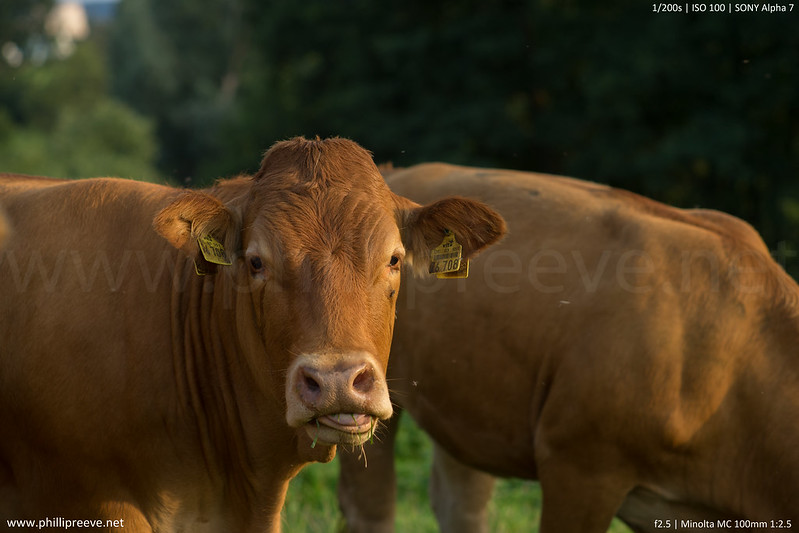
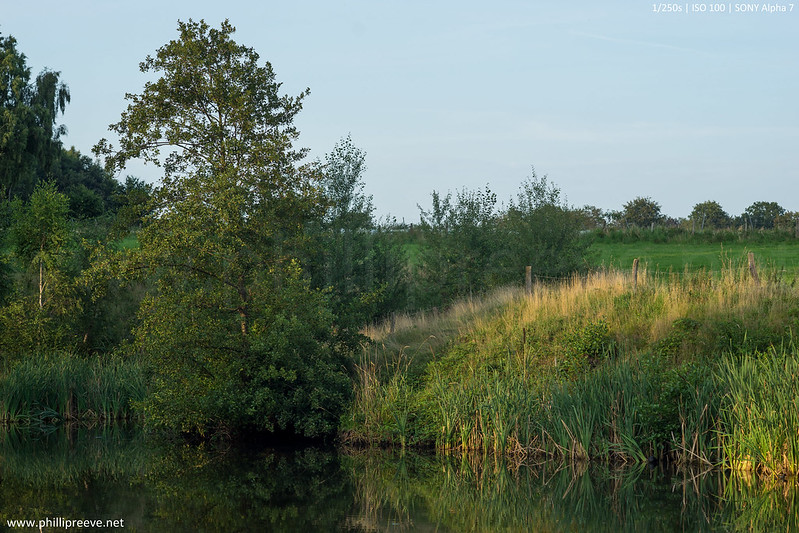
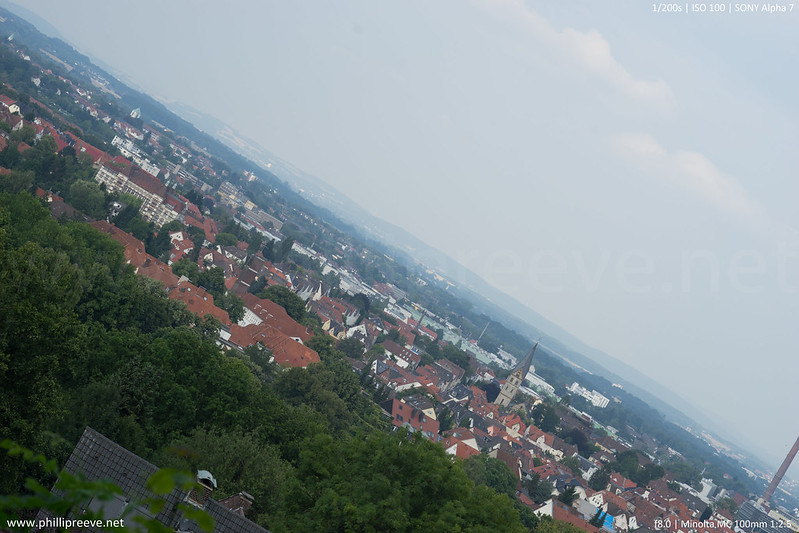
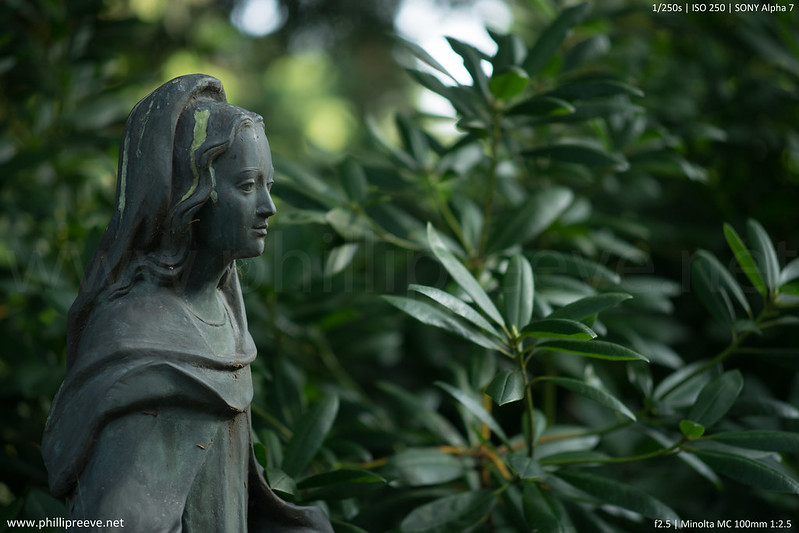

You can find more full resolution images in this flickr set: Minolta MC 2.5/100 full resolution sample images
Other Articles
An introduction to manual lenses on the a7
This site contains affiliate links. If you make a purchase using any of the links marked as affiliate links, I may receive a small commission at no additional cost to you. This helps support the creation of future content.
Latest posts by Phillip Reeve (see all)
- Review: Samyang AF 75/1.8 FE - April 12, 2021
- The FE-List now has 113 lenses on it - March 25, 2021
- 2020 – Year’s end review - December 28, 2020

Hi, really like all your reviews and give me good insight about manual lenses.
But minolta has a really good manual lens for EXTREME bokeh performance—–135mm STF, most creamy bokeh ever. The only downside is the CA and that’s it. No distortion, no vignetting and corner to corner sharpness even wide open.
who knows maybe I will test it some day 😉
A wonderful representation of the Minolta 2.5 / 100! Exactly this lens has seduced me to interact with old lenses to photograph on MFT cameras.
The 2.5 / 100 was the last lens that I would sell!
“Flare Resistance … not a strength of the MC 2.5/100” – leider, das Minolta 2,5/100 ist erheblich anfällig für helle Lichtquellen/hohe Kontraste, die sogar in einen breiten Winkel deutlich außerhalb des Objektfelds dazu führen, dass im Bild selbst größere Areale mit starker Kontrastreduzierung und diverse Reflexerscheinungen sehr störend auftreten können. Dieses Verhalten führt dazu, dass man ständig die Bildqualität auf diesen Mangel hin überprüft, was auf die Dauer lästig werden kann (bzw. einen nach einem besseren 100er greifen lässt – eine typische Erfahrung, die mir aus den 70er Jahren noch in Erinnerung ist).
“Not very effective coatings” – die oben beschriebene Kontrastverschlechterung ist in allen Blendenstufen vorhanden, lediglich die Ausprägung der Effekte ändert sich je nach Blende. Mit der Effektivität der Vergütung dieser MC 5/6er Optik hat das jedoch primär praktisch nichts zu tun, denn selbst die weitaus fortschrittlicheren Vergütungen späterer und im Aufbau ähnlicher MD 5/5er Versionen vermögen an dieser Streu- und Gegenlichtempfindlichkeit so gut wie nichts zu ändern. Die Ursachen liegen im prinzipiellen Aufbau der unsymmetrischen, praktisch unverkürzten Fernbrennweiten-Konstruktion (erweitertes Triplet, trotz negativem Korrekturglied baulängenbedingt eigentlich fast kein “Tele” mehr), die zwar zu hoher, sehr gut fehlerkorrigierter Auflösung schon bei größerer Öffnung fähig ist, schlussendlich Minolta jedoch damit kein insgesamt wirklich überzeuendes Spitzenobjektiv gerechnet hat.
Ganz so dramatisch wie du sehe ich das nicht, ja in ausgesprochenen Gegenlichtsituationen hat man ein Problem, das gilt aber so ziemlich für jedes Minolta MC oder MD Objektiv. Bei den jüngeren MD Objektiven ist das besser aber den Fortschritt seit dem halte ich für deutlich größer als jener der von frühen MC’s bis zu späten MD’s zu beobachten ist.
Um nicht ins Allgemeine abzuschweifen: explizit der neu gerechnete 5-Linser (ab 1976) erfuhr gegenüber dem 6-linsigen Vorgänger eine erhebliche Verbesserung, die sich v.a. in einer deutlich höheren Auflösung in den Bildecken bemerkbar macht (die optische Auslegung erinnert nicht wenig an ein 135mm-Sonnar mit einer dicken, zweiten Linse aus Glas mit geringer Dispersion, damals der Bedeutung angemessen “Sonderglas” genannt). Leider änderte sich trotz neuer Rechnung und besserer Vergütung nichts am extrem schlechten Gegenlichtverhalten, warum auch immer. Extrem soll heißen, dass bestimmte Objektive mit sogar mehr Glasflächen – z.B. das wahrlich uralte 5.6/100-200 oder das 4/70-210 – in dieser Disziplin das 2.5/100 unter vergleichbaren Bedingungen deutlich distanzieren. Für eine Festbrennweite vs. Zoom ziemlich ungewöhnlich…
Nebenbei, das 5.6/100-200 – an dieser Stelle sei es einmal kurz erwähnt: würde der legendäre Oldie nicht dem Zeitgeist zum Opfer gefallen sein – mit seiner Länge ist es wohl nicht kompakt- (obwohl es sich toll balancieren lässt) und für allgegenwärtige Bukeespielereien mit Offenblende nicht angemessen genug -, so liese sich ab f/8-f/11 in der 100mm-Stellung eine optische Leistung erkennen, die dem 2.5/100 schärfemäßig nicht nur das Wasser reichen kann, sondern es bezüglich Farbfehler (mit oder ohne MC-Vergütung) gerade auch in kritischen Gegenlichtsituationen glatt überflügelt – so wurde es nicht umsonst zum erfolgreichsten Minolta mit der längsten Bauzeit aller MF-Objektive überhaupt.
Great review for a great lens. Loving the bokeh, as good as 50mm 2.0
Would you recommend this as a portrait lens? Or is there a better minolta md for portrait work?
*Please fix the ebay.com affiliate links, one links to canon fd 50 1.4, the other opens ebay partners network.
Thanks.
I think there is no better portrait lens from Minolta.
Thanks for the hint about the links, just fixed them.
Very well done review. I’ve never used this lens on a digital body, it was one of my favorite lenses on my Minolta Xk and XD11. I used to own the MC, metal focusing ring version but sold it, I later repurchased a MD Rokkor-X (55mm filter) version. I like the newer version better and the MD versions have a better lens coating. When using it with a lens shade I rarely experienced flair. My lens produces warm rich colors and contrasts B&W images. I also own a 105 f2.5 ais Nikkor and 90mm f 2.8 Leica Elmerit. I’d put the image quality of the Minolta right up there with those lenses. I’m scanning my images at 7200dpi, full frame. I like Minolta’s corner sharpness better than Nikon’s ( comparing f5.6). You guys with smaller chip digitalis are only seeing the sweet spot, which must be very nice.
I have tried several times to buy a plain MD 2.5/100 because of the size and better coatings but they usually sold for a little more than I was willing to pay.
My Sony a7 has a full frame sensor which is the same size as the film you put into your XD11.
Aloha Phillip,
You are certainly teaching me so much about the Minolta lenses. I want to share with you that I just scored a deal on ebay for both the MC 100mm 2.5 and the MC 55mm 1.7 as a packaged deal! ($69 US) I guess since i read both of your reviews about those lenses over and over, the universe made some arrangements for me. Thank you so much for all the love and effort you put into teaching us. I own an A6000 and way too many Minolta lenses for my own good.
That’s avery nice set for a great price!
I bought the last MC version from 1976 after I studied this review. I prefer the waffle-kind focusing ring, lighter weight and the new lens design. I’m totally blown by the character this lens creates. My copy is already quite sharp wide open. And the contrast loose wide open is lovely. It’s perfect for portraiture and calm landscapes. I would have liked to go for the last MD version for it’s even lighter weight and 49 mm filter thread. But it’s nowhere available.
Thank you for your review, Phillip!
Hello Phil, the link f/2.5(soft) | is not correct. I think should be https://www.flickr.com/photos/96189377@N08/20487456852/in/dateposted
thanks 🙂
Hi Philip,
I’ve been enjoying your site for a couple of weeks now, my father in law gave me a MC58mm 1.4 and I have purchased an adapter and getting some great shots. I made my first purchase on ebay of a 100mm 2.5 and probably got ripped off.. The listing said un-tested, it should have said parts or repair. I didn’t spend much so I’ll take it as a learning lesson.
The gripe with it is that the focusing ring turns freely but doesn’t focus the lens. Is this repairable or the better question worth repairing? I’ve been googling with not a lot of luck finding answers.
btw, I did buy it with your referring link so hopefully you get something to keep your great site going.
Hi Matt,
sorry to hear about your bad start with buying manual lenses :(.
I am no expert when it comes to fixing lenses but my guess would be that it makes little economic sense to attempt fixing this lens when a replacement would be rather affordable and the issue is so serious.
Thanks for using the affiliate link and better luck next time 🙂
Hi Phillip,
I took this as a learning event so late last night I improvised a spanner wrench and dove in to the lens not really caring if I made it worse. It took me 30 min to take the lens apart and with that I identified that there were 3 screws that hold the focusing ring to the focusing helicoil in somewhat of a track. The screws were there but somehow the focusing ring was knocked out of the track. I was able to spin the focusing helicoil easily so my hopes improved.
I spent 4 more hours watching youtube videos copying what I saw others do to clean aperture blades and cleaning everything up and re-assembling the lens. Lets just say I am not good with tiny screws and figuring out how to get the aperture and infinity focus set properly but in the end I have a working lens and less than a full night’s sleep. I’ve only taken a couple of shots with the lens but it seems quite good.
I am psyched that I was able to get it going again and may take a chance to pick up other lenses that may have issues for a bit less cash.
I thnk we can tell that a happy end
Hi Phillip!
I have to say thank you for all you do on this website, it has helped me so much when deciding on lenses for my a7.
Right now I’m trying to decide on a sharp portrait lens for shooting both portraits and cars, and I need help deciding between the Bokina and this.
$280 CAN for a perfect Minolta 105 2.5
Or $468 CAN for a perfect Tokina 90 2.5?
Do you think the Bokina is worth the price?
the photos of the Deers are amzing!
First off, love that I found your page. It’s been a gem for me with all the knowledge I have soaked in the past few days.
I wanted to know what the key difference is between these two lenses.
MINOLTA MC TELE ROKKOR 100MM 1:2.5
MINOLTA MD 100MM 1:2.5
I have been going back and forth on with these two lenses, reading both your articles on them and I just decided to go with the: MINOLTA MC TELE ROKKOR 100MM 1:2.5
My first time buying vintage glass.
Thank you.
I think I have listed those at the end of the MD 2.5/100 review 🙂
Any difference in IQ between the MD you reviewed (https://phillipreeve.net/blog/review-minolta-md-100mm-12-5/) and MC Rokkor-PF version? There is a relatively significant price difference…just wondering if the extra money makes a difference.
Thanks in advance. Love your site.
Ha I just noticed the same question right above mine after posting. Sorry for the duplicate.
I see you reported that the MC Rokkor version is “a little less sharp”…how much less are we talking? Worth spending $100+ extra for the MD?
You can see the difference here:
http://artaphot.ch/minolta-sr/objektiv-vergleiche/326-nex-5n-und-100mm-objektive
How does it compare to the Canon 100/2?
Thanks…
—
Bill
EF or FD?
Sorry…FD
Hi Philip,
I am also looking between the Minolta, Canon FD and OM Zuiko. Any thoughts between these three?
Your reviews are amazing!
In the end I kept the Minolta plain MD because it seemed to have the nicest bokeh while also being small. Review: Minolta MD 100mm 1:2.5
Hi Phillip,
I just bought this lens and the close focus lens that you recommended. Can you clarify what you mean when you said it cant focus past 1.2 with the close focus attached? Does that mean you just attach the close focus lens and focus your image simply by moving closer/further from subject? Thank you!
You really like the bokeh of this lens better than the Bokina? Do you mean just in quantity or in quality too?
Not by a huge margin but yes. Bokeh is the quality of the blur, not the quantity.
I have this lens but not an A7 as yet. My question is ‘how were you able to get the EXIF data in the sample photos taken with this lens shown in Flickr’? Does this depend on the type of adapter used?
He likes to use this software.
Hi Phillip,
thank you for the fantastic review! Again it helps a lot getting a detailed view on this lens.
But is there maybe an error with the technical data? It reads as follows:
Max. Magnification ~0.2
Close Focusing Distance from the sensor 120cm
In the review of the Olympus OM Zuiko Auto-T 100mm 1:2 I can read:
Max. Magnification 0.2
Close Focusing Distance from the sensor 70 cm
This seems much more realistic to my experience.
Additionally the review of the Minolta MD 100mm 1:2.5 you write:
Max. Magnification 0.12
Close Focusing Distance from the sensor 1 m
This also seems realistic and is according to the data of the Olympus.
So this Minolta MC 100/2.5 should have a max. magnification of less than 1:10, maybe about 0.08. Is that correct?
regards
Peter
Hello,
Do you prefer more MC 6/5 or new MD 5/5 version for the portraits? Which one have better bokeh?